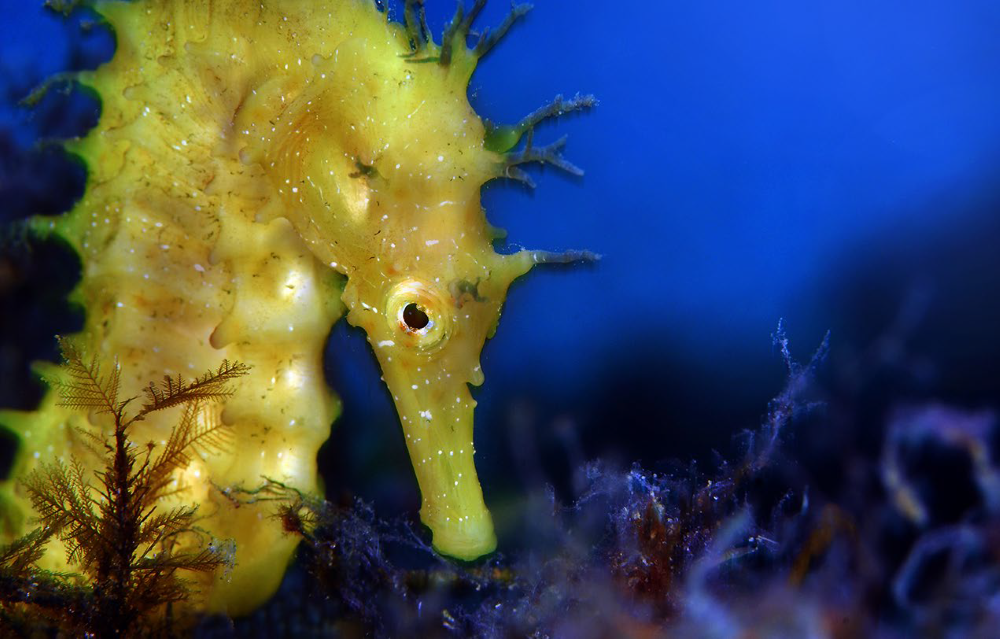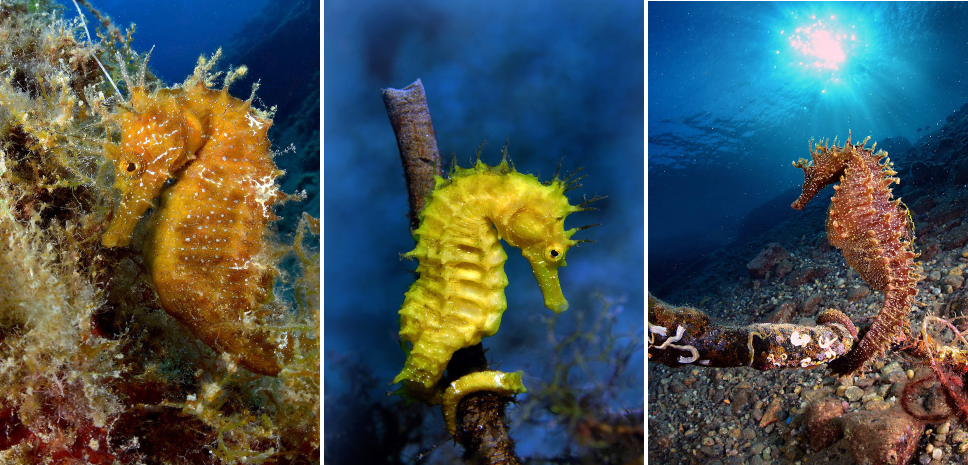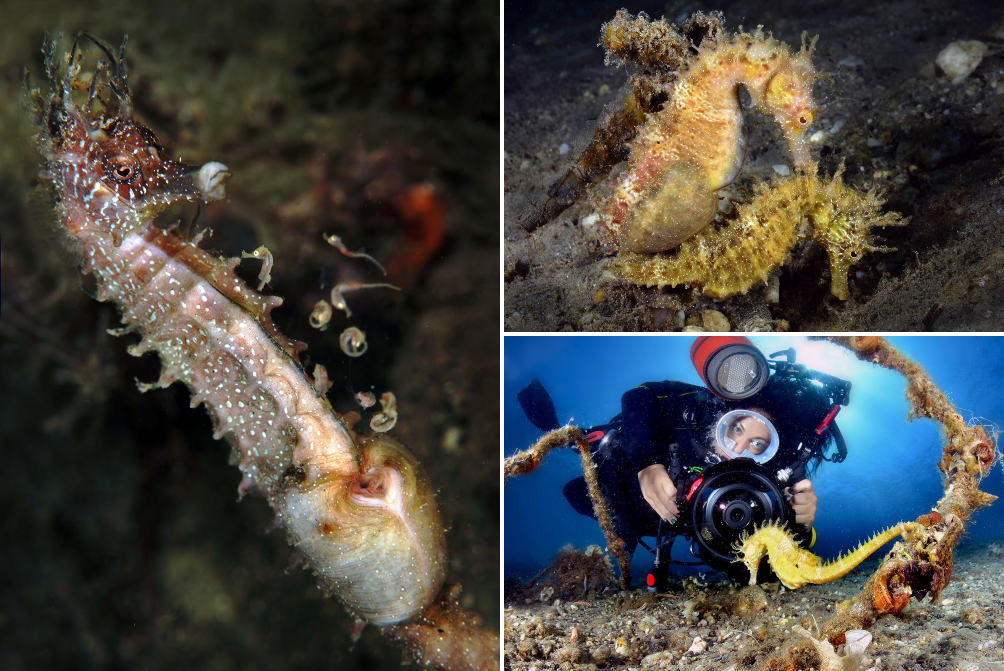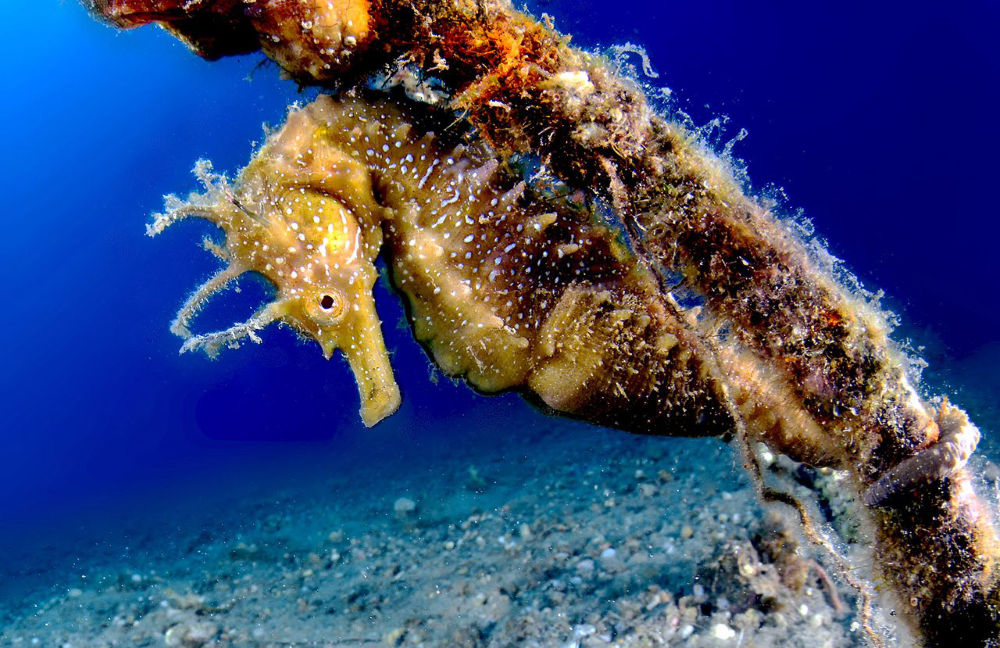A fish of the most unique, one of the most bizarre creatures that can be found in the sea, perhaps the most fascinating fish, is certainly the seahorse.
The beauty and tenderness, the unique look and unmistakable in the animal world as well as its lifestyle, which leads him to frequent the shallow water closest to coastal environments, since always populated by humans, makes this intriguing creature among the most famous animals of the sea since ancient times.

Plinius the Old perhaps first described the seahorse (23-79 d. C.) giving it the name of “Hippus”, from which the present name derives. The Greek name is a combination of hippos (horse) and kampos (sea monster). Naturalists of the past report that the powder obtained from its remains was used in pharmacopoeia. There are talk of seahorses roasted and applied to a wound, of its powder mixed with vinegar or with honey to create miraculous ointments, and many other pretty strange uses. Nevertheless, Eliano explained, the hippocampus could be at the same time toxic or even poisonous. It is said that the horse stomach dissolved into wine would become an extraordinary lethal poison. In fact, it would not be the fish’s stomach to cause the poisoning, but a very rare alga the seahorse eats and that would then be responsible for evil properties.
According to Plinius, the ashes of this fish, combined with marjoram oil or mixed with pitch, would serve as a cure for skin rashes, hair loss, and the bite of rabid dogs. Even Aristotle talks about it in his “Animal’s Reproduction”, probably fascinated by the reproductive peculiarities of this unique species. Even today, some still maintain that seahorses have the power to ward off diseases. Until a few years ago, for this reason, in Venice and in the Venetian lagoon they used to hang them in groups of three inside the houses.
For Greek poets the hippocampus was instead a mythical creature; the gods used it to cross the seas and mythological scenes represent it sometimes like a horse with a fish or dolphin bottom. According to the Greeks, precisely four seahorses, surrounded by an escort of Tritons and Nereids, pulled Poseidon’s chariot. A scene, with a little fantasy, nothing short than magnificent: can you imagine Poseidon, the Sea God, who moves fast under the sea on a chariot pulled by sea horses, surrounded by incredible figures like Nereids, mermaids and Tritons, half fish and half men? Many artists of past eras dreamed and skillfully reproduced the scene sometimes so very addictive, enough to drag the viewer into a magical world, densely populated by little known or unknown animal and plant forms, often the result of their imagination! And how would you call an animal resembling a horse that pulls the chariot of Neptune, if not “steed of the sea”? Animals of a parallel world, the seahorses of Neptune’s chariot took the appearance of terrestrial horses adapted to the water world. Many sculptures testify this fact and there are many examples. Just think of the many fountains of Neptune scattered in the Italian cities, usually adorned with sea horses; like that of Florence, in Piazza della Signoria, near the corner of Palazzo Vecchio, by meo Ammannati (1563-1565) and some of his students. The figure of Neptune stands on a pedestal decorated with the statues of Scylla and Charybdis at the center of an octagonal basin, where the statues appear to be moved by sea horses, dancing satyrs and river gods. Also in Rome, in Piazza Navona, there is a Fountain of Neptune, dated 1873. Again seahorses, mermaids and cherubs playing with dolphins in a harmony that almost makes alive the carved stone. Sculptors and painters sometimes added to the hippocampus two wings like Pegasus, probably inspired by the rapid movement of the dorsal fin that vaguely resembles the wings of a butterfly.
The seahorse is also apotropaic symbol. In the past, small seahorses images were used against the evil eye, so much so that these animals have been reproduced in many paintings, like those found in Pompeii. They were painted, for example, on the outer walls of the houses, to protect tenants from bad luck or even on the sides of the boats, for the safeguard of fishermen and fishing. In some Mediterranean traditions, the seahorse was considered the helmsman of the dead’s boat to the afterlife. Other times, like the dolphin, the hippocampus was a charitable savior. The fish is also depicted, with or without wings, in the decorations of the catacombs and later in Christian art. During the middle Ages the hippocampus was used in heraldry, where usually symbolized a commendable action taken at sea, or in the coat of arms of a port, where instead alluded to the trade departing from that place.

Moving on from mythology to science, we know that the first biologists and naturalists who studied the seahorses were extremely perplexed in observing their characteristics. The structure and shape of the “steeds” of the underwater world are in fact born as by a set of portions of different animals: the head is very similar to that of a horse, the prehensile and elongated tail resembles that of a monkey, the pouch that the males are fitted with follows a bit the shape of the kangaroo’s one, and the protruding eyes, which move independently of each other, seem to be those of a chameleon. It is estimated that in nature there are about 33 species of seahorses, living between the tropics and the temperate areas of the blue planet.
Wanting to draw its own “identity card”, we can immediately identify these fish as belonging to the Syngnathidae family. Of the 33 known species, the largest number of them live in the Indo Pacific region. Australia has about 14 species and Japan 7. In temperate waters of the Mediterranean and North Atlantic we find only two species, both common: Hippocampus hippocampus (Linnaeus, 1758) – snub-nosed seahorse, and Hippocampus ramulosus (Leach, 1814) – seahorse. They both live in bays and inlets near the coast, up to about 30 meters deep, and their home is made up of the bushy marine vegetation grasslands (especially Posidonia beds), but not only.
The seahorses are small fishes, thin, elongated, with the body protected by a series of rings and bone plates. Their bodies are very compressed at the sides and rich in roughness, due to multiple skin rings, sometimes thorny and sometimes not depending on the species. The rings are particularly evident and their number varies from 10 to 12 in the trunk and 34 to 39 in the tail. The bone plates, which together form a true armor, are joined in correspondence of the rings (practically corresponding to the vertebrae), functional joints which ensure a certain mobility to the animal’s body. On the plates and rings there are, variously distributed, carinas, granulations and tubercles that constitute diagnostic characters useful for the identification of the different species. The presence of this armor explains the ease with which these animals can be preserved without special care, leaving them in the sun until the complete drying. On the back and on the head are often present numerous dermal appendages, which may be simple or branched.

Notable in all species of seahorses are the eyes, with independent movements that allow to simultaneously observing in different directions. With regard to the fins, we find a beautiful fan-shaped dorsal fin, which extends on the two terminals rings of the dorsal trunk; a small anal fin inserted on the first tail ring; two pectoral implanted behind the operculum and also rather small; no ventral or tail fin. The tail is prehensile and is totally different from a classic tail fin. If you try holding a sea horse’s tail gently between your bare fingers, of course under water, you can appreciate the strange feeling that the prehensile tail transmits when it twists the finger, squeezing it as does the hand of a newborn baby when you put your finger in its center. The brooder pocket (or pouch) is located immediately after the anal opening and is a typical pocket-shaped bag, closed for almost its entire length with only one small opening allowing the introduction of the eggs and the subsequent birth of the babies. In all Syngnathidae, the female lays her eggs in the male’s incubator pouch, who then broods them for a period of minimum eight to ten days. The incubation time depends on the species and on water temperature.
Another distinctive characteristic of the seahorse is having the jaws fused together in a mouth tube, a trait in which the family owe its name: the union of the Greek words “sun”, together, and “gnathos”, jaw, create in fact Syngnathidae. Elongated, with the terminal opening facing upwards and without teeth, the mouth opening is very small and allows only a highly selective diet. The absence of a real dentition compels the seahorses to suck the food, consisting of small crustaceans and various animals of the zooplankton. Feeding on live prey, seahorses had to develop very sophisticated hunting techniques, being lazy by nature in the movements and not being able to chase prey. A real aspirant current, combined with a lightning snap of the mouth and head forward, leads the small prey to end up in the belly of the seahorse so quickly that the human eye cannot perceive it. The animal, equipped with independent eyes, has the ability to follow every minimum movement of its prey without moving the head, exploiting its mimetic capacity related, among other things, also to immobility. Thereby it triggers its perfect suction mechanism at the right time: the jaw is lowered, the mouth widens and the backwash resulting from the coordination of such movements leads the prey directly in the mouth, with such force that sometimes the small prey are crushed by the impact!
Although they seem shy and quiet, these fishes are voracious: the young are able to eat even ten hours a day, during which they can swal low up to 3000 crustacean larvae. So much so that at two months of age can exceed over five centimeters in length. The seahorses stand in the upright position, with the head bent forward to form a right angle with the axis of the body. The upward thrust of the swim bladder, whose volume changes are helpful in vertical displacements, also guarantees the maintenance of this position. Only in case of danger, the seahorses abandon the vertical position. They use the head to decide a direction while swimming: in fact, changing the position of the head, they move their center of gravity and alter the relationship between the pectoral fins and dorsal fin, which normally are synchronized with the same vibratory rate. When seahorses move quickly, i.e. in cases of absolute necessity, the fins may perform up to thirty-five vibrations per second. In these cases, they are usually in a horizontal position, head forward and tail lying parallel to the seabed. Slow movements are performed in an upright or diagonal position with respect to the bottom and, in this case, the long tail is folded back on itself with the end shaped like a curl. Being bad swimmers, anyway they move hardly ever and prefer using the prehensile tail to anchor to the ribbon-like leaves of the sea grass or seaweed or any suitable substrate that can be found near the bottom.
The coloring of the hippocampus can range from black-brown with white spots to red, orange and brown up to yellow, with various inserts of spots or stripes of different colors. The patterning may also vary depending on the living environment and, for example in the Mediterranean, we find color differences between seahorses from the Adriatic, the Tyrrhenian and the Ionian Sea, as well as differences between the two species found in these seas. The length of the different species ranges between 15 and 30 cm.

Regarding reproduction, anomaly of the animal kingdom, among seahorses are the males to give birth to their young. They are the only living beings in the world where just the male is responsible for the birth of the larvae. In addition, seahorses are in some cases even monogamous, that is during their lives they remain beside one companion only, and this is a unique characteristic among most of the species living in the sea. The male seahorse is clearly recognizable by the presence of the pouch, while the female has a rounded abdomen without pouch. Most seahorses are already sexually active by the first 6-8 months of life. In spring, when the water starts to warm up, for seahorses begin the mating season. Combined in couples that can remain together for life, the seahorses begin to make unusual movements of extraordinary elegance: that is they start courting. After a few days of courtship, seahorses mate. The female, in some cases by twisting the tail with that of the male prior to contact, in others simply bringing its abdomen in contact with that of her companion, emits the eggs, which are appropriately transferred in the pouch of the male, who in the meantime had prepared to receive them and who, simultaneously, releases the sperm.
The crucial moment, when the female lays eggs in the male’s pocket, requires perfect timing and it often happens that, perhaps for the couple’s inexperience, the operation will not succeed. The eggs, whose diameter measure a few millimeters, adhere to the inner sides of “Dad’s belly”, thus receiving the nutrients needed during pregnancy. The male carries the “pregnancy” for a period ranging from several days to several weeks. During childbirth, the male attaches by his tail to a suitable support and begin to expel the babies through contractions very similar to those of a human woman in labor. At birth the little seahorses measure few millimeters and are totally formed, an adult miniature reproduction. It will always be the male to take care of the offspring. On average, the eggs laid vary in number from a minimum of five to over 1200: everything depends on the species and the size of parents. The newborn babies measure from 8 to 18 millimeters, depending on the species and are immediately ready to feed at full tilt. One of the most frequent complications in childbirth of a seahorse comes from the fact that some of the embryos may die inside the incubator pouch, even before hatching, and this determines undesirable gas formation. The male could swell like a balloon and rise to the surface, thus becoming prey to other larger fish (seahorses were found in the stomachs of tunas and other species of carnivorous fish). In the wild it is very rare to observe the male’s contortions while giving birth, and even more unlikely to observe the female laying eggs in the male’s pouch. In some species of seahorses, that activity seems to take place only at night.

Today we must remember that all the existing species of seahorses are, unfortunately, classified in the Red List of Animals in Danger of Extinction (IUCN), as particularly susceptible to the devastating action that mankind is making, not only against them. According to some estimates, there are more than 42 million seahorses sold every year in the Chinese Traditional Medicine Market. Such a request for seahorses, along with the destruction of their natural habitat, is determining the current “critical situation”. Tough times, therefore, for seahorses, also caught to supply the aquariums around the world. In the early 90’s only Asia “consumed” nearly 16 million specimens a year. The low birth rate and a short life span must push governments to increase the levels of protection for these particularly sensitive species. Their behavior and the state of the environment particularly expose seahorses to the problem of their over-exploitation. Their low mobility and reduced ability to live in environments other than coastal ones, makes these animals easy prey for fishermen, especially of those performing trawling and gill-net. The extreme fidelity of couples result in a social structure easily threatened by the event of the lack of one partner, which would decrease the possibility of reproduction. The length of parental cares, together with the small size of the larvae, therefore limit the reproductive rate of the species. Capturing a pregnant male means also taking the larvae that it carries, and a new generation is destroyed at once. In different natural environments, the population of sea horses shows, today, a decrease oscillating between 10% and 70%. To give an idea about their commercial preciousness, just remember that their prices far exceeds that of silver, touching at times the price for a kilo of gold. During the Convention on International Trade in Endangered Species (CITES), held in Santiago de Chile in 2002, it was finally decided to protect all the 33 known species of seahorses, which will no longer be traded freely like it has been done so far. This decision does not exclude their trade, but imposes on all the Members increased and tighter controls. The rules state that every nation, with the support of CITES, certifies the regularity of all catches and especially checks every sale. The nations that are home to sea horses in their waters are 105, and 69 nations trade them officially. Among them Brazil, the Philippines and Indonesia are major exporters, while the US and Western Europe are among the largest importers. The largest exporters of dried seahorses are instead India, Thailand, the Philippines and Mexico, while China and Hong Kong are the largest importers.
The priorities to be considered for the conservation of the species are the maintenance of coastal natural habitats and the development of a specific international community, formed by fishermen and seahorses breeders. If no action is taken in the short term, it is likely that more late interventions can then be vain.
Only the commitment of everyone and a full awareness of the mechanisms in place will slow down this frantic man race to nowhere…
WORDS and PICTURES by Francesco Turano


















